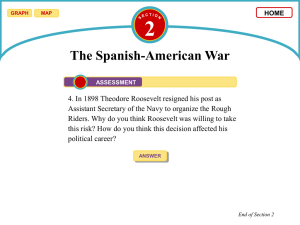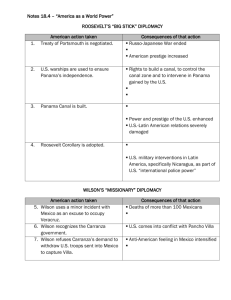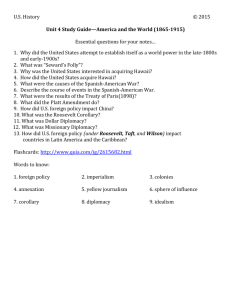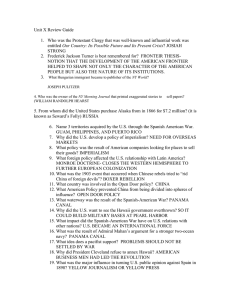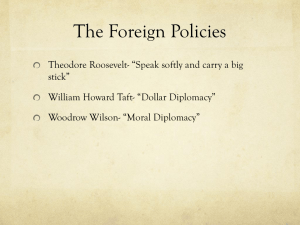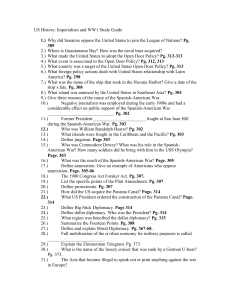Unit 3 Organizer: US Foreign Policy & World War I (1898—1919)
advertisement
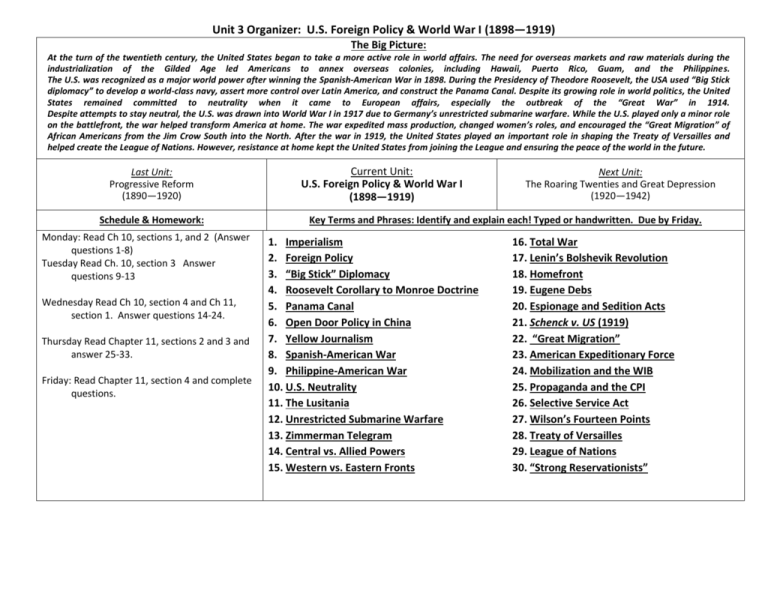
Unit 3 Organizer: U.S. Foreign Policy & World War I (1898—1919) The Big Picture: At the turn of the twentieth century, the United States began to take a more active role in world affairs. The need for overseas markets and raw materials during the industrialization of the Gilded Age led Americans to annex overseas colonies, including Hawaii, Puerto Rico, Guam, and the Philippines. The U.S. was recognized as a major world power after winning the Spanish-American War in 1898. During the Presidency of Theodore Roosevelt, the USA used “Big Stick diplomacy” to develop a world-class navy, assert more control over Latin America, and construct the Panama Canal. Despite its growing role in world politics, the United States remained committed to neutrality when it came to European affairs, especially the outbreak of the “Great War” in 1914. Despite attempts to stay neutral, the U.S. was drawn into World War I in 1917 due to Germany’s unrestricted submarine warfare. While the U.S. played only a minor role on the battlefront, the war helped transform America at home. The war expedited mass production, changed women’s roles, and encouraged the “Great Migration” of African Americans from the Jim Crow South into the North. After the war in 1919, the United States played an important role in shaping the Treaty of Versailles and helped create the League of Nations. However, resistance at home kept the United States from joining the League and ensuring the peace of the world in the future. Last Unit: Progressive Reform (1890—1920) Schedule & Homework: Monday: Read Ch 10, sections 1, and 2 (Answer questions 1-8) Tuesday Read Ch. 10, section 3 Answer questions 9-13 Wednesday Read Ch 10, section 4 and Ch 11, section 1. Answer questions 14-24. Thursday Read Chapter 11, sections 2 and 3 and answer 25-33. Friday: Read Chapter 11, section 4 and complete questions. Current Unit: U.S. Foreign Policy & World War I (1898—1919) Next Unit: The Roaring Twenties and Great Depression (1920—1942) Key Terms and Phrases: Identify and explain each! Typed or handwritten. Due by Friday. 1. Imperialism 2. Foreign Policy 3. “Big Stick” Diplomacy 4. Roosevelt Corollary to Monroe Doctrine 5. Panama Canal 6. Open Door Policy in China 7. Yellow Journalism 8. Spanish-American War 9. Philippine-American War 10. U.S. Neutrality 11. The Lusitania 12. Unrestricted Submarine Warfare 13. Zimmerman Telegram 14. Central vs. Allied Powers 15. Western vs. Eastern Fronts 16. Total War 17. Lenin’s Bolshevik Revolution 18. Homefront 19. Eugene Debs 20. Espionage and Sedition Acts 21. Schenck v. US (1919) 22. “Great Migration” 23. American Expeditionary Force 24. Mobilization and the WIB 25. Propaganda and the CPI 26. Selective Service Act 27. Wilson’s Fourteen Points 28. Treaty of Versailles 29. League of Nations 30. “Strong Reservationists” Unit 3 Reading Guide U.S. Foreign Policy & World War I Chapter 10, Section 1 1. Define IMPERIALISM: 2. Who was the leader of the “build a bigger, more powerful navy” movement in the United States after the Civil War? Name: ________________ 6. What event (February 15, 1898) led to war between the United States and Spain? 7. What role did Theodore Roosevelt play during the Spanish-American War? 8. What three territories did the United States annex at the end of the Spanish–American War? 3. What territory, purchased from Russia in 1867, was called “Seward’s Icebox?” 4. Why did American sugar planters in Hawaii favor annexation by the United States? Chapter 10, Section 2 5. Why did the newspaper publishers Joseph Pulitzer and William Randolph Hearst encourage “yellow journalism” during the Cuban Revolution? Chapter 10, Section 3 9. Name three reasons the USA wanted to build the Panama Canal. 10. What was the most important reason for the United States to maintain a strong political presence in Cuba following the Spanish–American War? 11. Which former Spanish colonial territory fought a four year war for independence against the United States, beginning in 1899? 12. Explain the Open Door policy concerning trade with China. 13. What “three beliefs” became the focus of U.S foreign policy in the early 1900s? 16. Which U.S. president’s “big stick diplomacy” was based on the African proverb, “Speak softly and carry a big stick? 17. How was the Roosevelt Corollary to the Monroe Doctrine a radical change in American foreign policy? 18. Which U. S. president used “dollar diplomacy” to deal with Latin America? 19. Why did Woodrow Wilson call Mexico “a government of butchers?” Chapter 10, Section 4 14. Why did Theodore Roosevelt win the Nobel Peace Prize in 1906? Chapter 11, Section 1 20. What were the four long–term causes of World War I? 15. Panama was a province of what South American country prior to winning independence in 1903? 21. How did problems in the Balkans and the assassination of Franz Ferdinand lead to the outbreak of World War I? 26. What naval tactic reduced Allied ship losses to German submarines as ships crossed the Atlantic to deliver critical war supplies? 27. What was the American Expeditionary Force? 22. When World War I began, what was the position of the U. S. government regarding entry to the war? 28. Name three reasons for the historically high casualty rates caused by World War I. 23. What happened on May 7, 1915 that caused a change in American public opinion against Germany? 24. In the “Zimmerman note,” Germany tried to convince a country to join them in a war against the United States – what country? Chapter 11, Section 2 25. What act of Congress established a military draft in 1917? Chapter 11, Section 3 29. What role did the War Industries Board and the Committee on Public Information play in helping the USA fight World War I? 30. Define PROPAGANDA: 31. What laws were passed by Congress in 1917 and 1918 to limit criticism of the federal government’s war efforts? 32. 35. Why did Wilson want to create a League of Nations? 36. What four countries dominated the Paris Peace Conference following WW I? What was “the Great Migration?” 33. What was the importance of the Supreme Court case of Schenck v U.S. (1919)? 37. In what way was Germany “humiliated” by the Treaty of Versailles? 38. Why did the U.S. Senate refuse to ratify the Treaty of Versailles? Chapter 11, Section 4 34. What were the second, fourth, and fourteenth points of President Wilson’s “Fourteen Points” peace plan?
